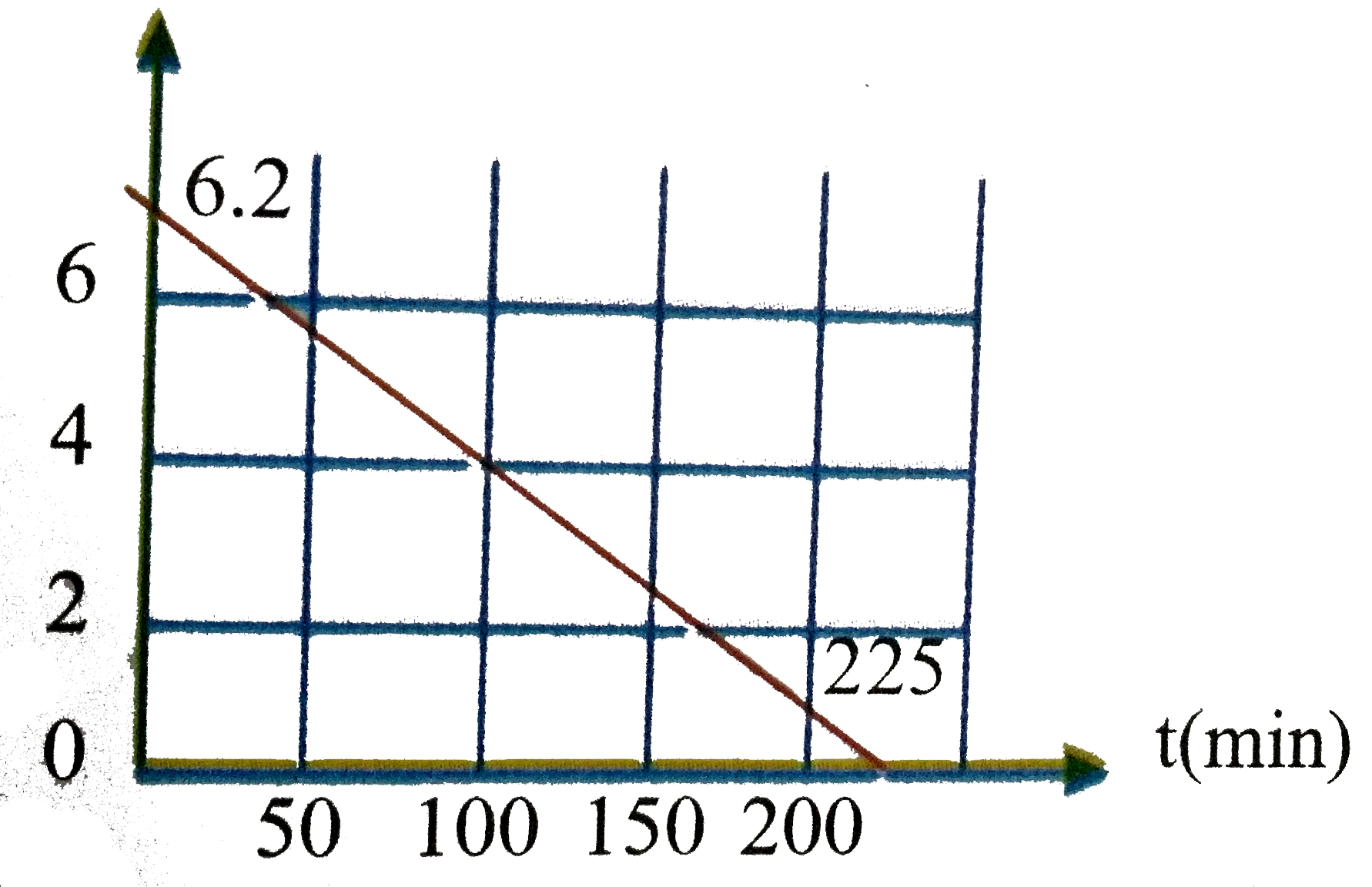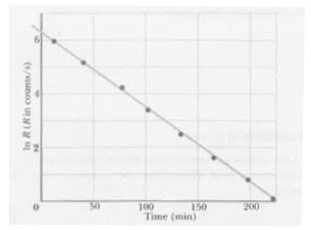The table that follows shows some measurements of the decay rate of a sample of .128I, a radio nuclide often used medically as a tracer to measure the rate at which iodine is absorbed by the thyroid gland.
∣∣
∣
∣
∣
∣
∣∣Time(min)A(counts/s)Time(min)A(counts)/s4392.213210.936161.41644.566865.51961.861026.82181.00∣∣
∣
∣
∣
∣
∣∣

The half life t1/2 for this radio nuclide.
The disintegration constant λ determines the exponenetial rate at which the decay rate R decreases with time t (as indicated by Eq. 40 -17, R=R0e−λ ). Therefore we should be able to determin λ by plotting the measurements of R against the measurement times t. However, obtaining λ from a plot of R versus t is difficult because R decreases exponentially with l, according to Eq. 40-17. A neat solution is to transform eq. 40 -17 into a linear function of t, so that we can easily find λ. To do so we take the natural logarithms of both sides of Eq. 40 -17.
Calculations: We obtain
In ~r=In(R0e−λt)=InR0+In(e−λt)
=InR0−λt (40-20)
Because eq. 40 -20 9s of the form y=b+mx with b and m constants, itis a linear equation giving the quantity in R as a function of t. Thus, we plot In R (instead of R) versus t, we should get a straight line. Further, the slope of the line should be equal to −λ).
Figure 40 -11 shows a plot of In R versus time t for the given measurements. The slope of the straight line that fits through the plottd points is
slope =0−6.2225min−0=−0.276min−1
Thus −λ−0.0276min−1
or λ=0.0276min≈1.7h−1
The time for the decay rate R to decrease by 1/2 is related to the disintegration constant λ via Eq. 40 -19 (T1/2=(In2)/λ). From the equation. We find
T1/2=In2λ=In20.0276min−1≈25 min.

Topper's Solved these Questions
- BOOK - RESNICK AND HALLIDAYCHAPTER - THE NUCLEUSEXERCISE - CHECKPOINT5videos
THE NUCLEUS
- BOOK - RESNICK AND HALLIDAYCHAPTER - THE NUCLEUSEXERCISE - PROBLEMS66videos
THE NUCLEUS
- BOOK - RESNICK AND HALLIDAYCHAPTER - THE KINETIC THEORY OF GASESEXERCISE - PRACTICE QUESTIONS72videos
THE KINETIC THEORY OF GASES
- BOOK - RESNICK AND HALLIDAYCHAPTER - UNITS AND MEASUREMENT EXERCISE - PRACTICE QUESTIONS (MATRIX-MATCH)11videos
UNITS AND MEASUREMENT
Similar Questions
For an elementary, 2A+B→3C, the rate of appearance of C at time 't' is 1⋅3×10−4mol L−1s−1. Calculate at this time (i) rate of the reaction (ii) rate of disappearance of A.
View SolutionFor an elementary reaction
2A+B→3C
the rate of appearance of C at time 't' is 1.3×10−4mol L−1s−1.
Calculate at this time
(i) rate of the reaction.
(ii) rate of disappearance of A.View Solution
Knowledge Check
- Question 1 - Select One
The half-life of a sample of a radioactive substance is 1 hour. If 8×1010 atoms are present at t=0, then the number of atoms decayed in the duration t=2 hour to t=4 hour will be
A2×1010B1.5×1010CZeroDInfinity - Question 2 - Select One
The half-life of a sample of a radioactive substance is 1 hour. If 8×1010 atoms are present at t=0, then the number of atoms decayed in the duration t=2 hour to t=4 hour will be
A2×1010B1.5×1010CzeroDinfinity - Question 3 - Select One
A first order reaction is found to have a rate constant, k=4.2×10−12s−1. Find the half-life of the reaction.
A1.26×1013sB1.65×1011sC1.65×10−11sD1.26×10−13s
For an elementary reaction
2A+B→3C
the rate of disappearance of C at time t is 1.3×10−4mol L−1s−1. Calculate at this time
(i) rate of the reaction.
(ii) rate of disappearance of A.View SolutionCane sugar is gradualaly converted into dextrose and laevuloe by dilute acid. The rate of inversion is observed by measuring the polarisation angle, at various times, when the following results are obtained:
Time (min)010203040100∞Angle32.428.825.522.419.6−6.1−14.1
Show that the reaction is of first order. Calculate the value of t, when the solution is optically inactive.View SolutionFor the elementary reaction 2A+B→3C, if the rate of appearance of C at time 't' is 1.3×10−4molL−1s−1, calculate at this time (i) rate of the reaction (ii) rate of disappearance of A.
View SolutionThe half-life of a radioactive substance against α−decay is 1.2×107s. What is the decay rate for 4×1015 atoms of the substance ?
View SolutionFor a first order reactin, rate constant is given is logk=14−1.2×104T, then what will be value of temperature if its half life period is 6.93×10−3min ?
View Solution

